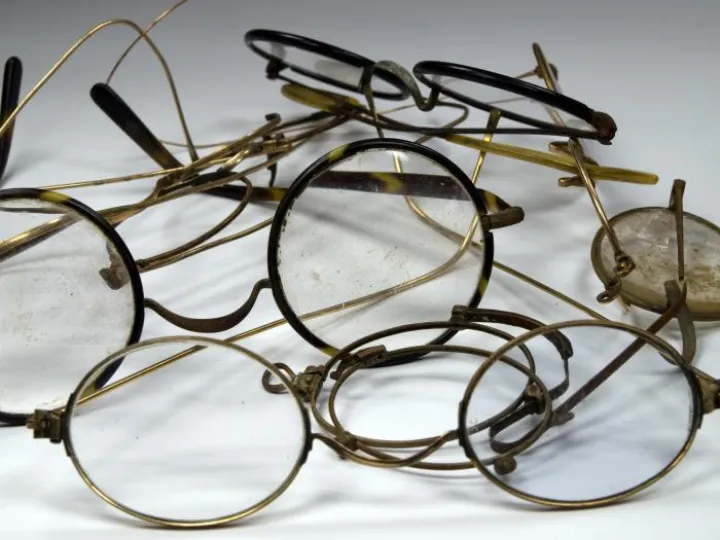Materials matter in repairing glasses
Glasses have unique qualities
At AlphaOmega, our frame repair experts in our busy workshops come across spectacles and sunglasses in many styles and are manufactured from a vast range of materials. Spectacle repairs to frames and lenses can be challenging as eyewear comes in a variety of designs and colours. Frames can be manufactured in anything, from cheap plastic to precious metals.
Each spectacle frame that arrives at our workshop will have unique qualities in terms of strength, durability, weight, colour and price. Whatever the problem, our highly trained and experienced staff are always up to the repair task. Here is a rundown of the leading materials that can go into manufacturing modern-day spectacles and sunglasses.
Nylon sunglasses
Spectacle frames made of nylon were introduced after World War Two, but the brittle nature of early plastics forced manufacturers to switch to far superior nylons, even if they were more expensive. Modern blended nylon frames have the advantage of being both strong, pliable, durable and lightweight – all factors that play a big part in providing comfort for the wearer and long life for the product.
Blended nylon is still the material of choice for sports and performance frames. These are usually made of gliamides, grilamid or trogamid blends, as these can cope with hot and cold conditions without becoming brittle with use. They can also be easily shaped to create the modern wraparound sunglasses styles that have become so popular. The pliable nature of the material also makes the job much easier when it comes to glasses repair.
One of the most popular materials for modern sunglasses is a cellulose acetate called zylonite. This offers cheap, lightweight frames in various colours, a real bonus for modern eyewear manufacturers. Another popular cellulose acetate on the market today is called propionate. This type of nylon is both lightweight and hypoallergenic. The colours also have a high gloss sheen, making it the material of choice for the more outrageous and eye-catching designer sunglasses often seen on shop shelves today.
Repairs to nylon frames do present some problems. Nylon-based glasses are easier to break than those with metal frames, and they still tend to become a little more brittle with age, especially after prolonged exposure to sunlight.
Metal framed spectacles
Spectacle frames may be manufactured from a broad range of metals. Many of the cheaper spectacles made today are mainly a blend of metals known as monel, preferred for their high malleability and resistance to corrosion. However, some people find the nickel in monel-manufactured spectacles mildly irritating to the skin. More expensive frames are now plated with palladium or some other nickel-free alloy.
Stainless steel glasses frames are an excellent alternative to monel as they combine low weight with low toxicity and high strength. Stainless steel is an alloy of steel and chromium, but spectacle frames often contain other metal elements. The addition of chromium gives excellent resistance to corrosion, abrasion and heat.As they are free of nickel, stainless steel glasses are also hypoallergenic.
Spectacle frames may also be made from aluminium. These are lightweight, corrosion-resistant, and much favoured by high-end designers who like the unique look of aluminium spectacles. But pure aluminium is quite soft and weak, so small amounts of silicon are often added for strength and durability.
Titanium has become a popular material for spectacle frames in recent years. Titanium is lightweight, durable, hypoallergenic, corrosion-resistant, and comes in various colours. Titanium is also expensive. Some frames are made from an alloy of titanium and other metals, such as nickel or copper, to reduce manufacturing costs.
Beryllium is another low-cost alternative to titanium and makes an excellent choice for those with high skin acidity or who spend a lot of time in the sea or other saltwater environments. Lightweight, flexible and robust beryllium spectacles come in various colours.
Precious metals
In the search for unique spectacle frames to tempt potential customers, designers have turned to some unusual materials. In glasses repair, our technicians occasionally come across silver spectacle frames. Solid silver is too heavy to be comfortable, but silver can sometimes be used in the alloy to give a jewel-like accent to nylon frames.
Like silver, gold plating can also accentuate plastic or metal frames, as are precious or semi-precious stones. Popular stones are onyx and turquoise, but even diamonds can be used to add glamour. Repair of gold or diamond spectacles may require particular care, but the approach is much the same as with non-precious materials. Rhinestones, for example, are a much cheaper alternative, used nowadays to lend a retro look to modern spectacles and sunglasses.
Special materials
Sometimes, the staff at AlphaOmega have to deal with special handmade glasses; many of these can be made of unusual materials such as wood, bamboo, bone or animal horn. These materials can present particular challenges in glasses repair. Although less pliable and durable than other materials, they offer a unique look.
We have handled spectacle repairs in buffalo horn, bamboo, and vinyl. Please note that materials that are 'split', especially wood or horn, may not be repairable. Many unusual materials can be used to lend accents to spectacle frames.
Leather, velvet, and even feathers can be incorporated into specialist designs, making spectacle repairs challenging. Despite the array of materials used in spectacles design, we have the staff and equipment at AlphaOmega to provide the best repair possible at a price you can afford.
More on materials
Anatomy of glasses frames
Titanium takes off
Oakley for sportswear


